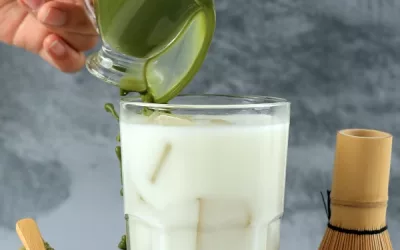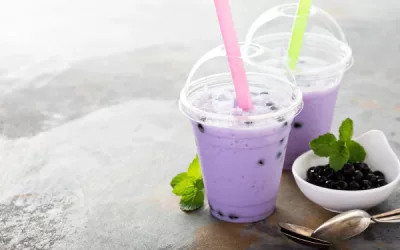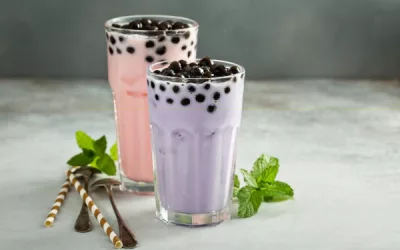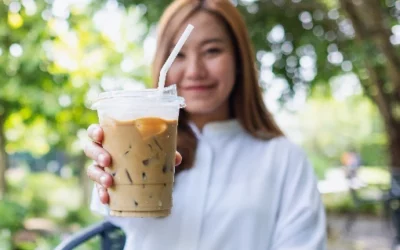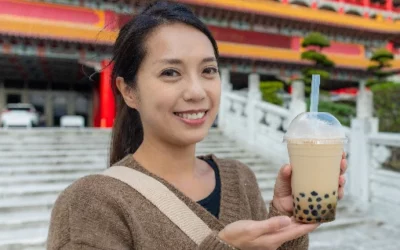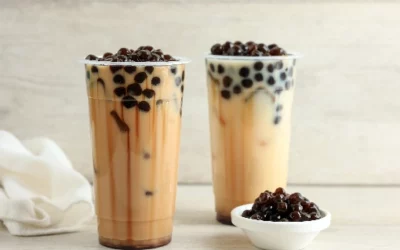It was a rainy afternoon when I first tried making bubble tea at home. I remember the excitement as I stood in the kitchen. Making bubble tea at home is not just fun; it’s also a great way to customise your drink exactly how you like it. In this article, I’ll guide you through the easy steps, share tips for customisation, and even suggest some cost-effective alternatives. Whether you’re a novice or a bubble tea fan looking to elevate your skills, let’s dive into the sweet and satisfying world of bubble tea!
Table of Content
- What ingredients and equipment do I need for bubble tea?
- How do I prepare the tapioca pearls?
- How do I brew the perfect tea for bubble tea?
- How do I assemble my bubble tea?
- What are some flavour variations for bubble tea?
- How can I customise my bubble tea?
- How can I make bubble tea more cost-effective?
- Conclusion
What ingredients and equipment do I need for bubble tea?
If you’re diving into making bubble tea at home, you’re in for a treat. Bubble tea is a delightful blend of textures and flavours, and the process of making it is almost as enjoyable as sipping on the final product. To get started, you’ll need some essential ingredients and a few pieces of equipment.
First off, let’s chat about the ingredients:
- Tea Leaves: You can use various types of tea leaves like black tea, green tea, oolong, or even herbal teas.
- Tapioca Pearls: These are the chewy, fun-filled pearls that make bubble tea unique.
- Milk: Choose from whole milk, almond milk, soy milk, or oat milk based on your preference.
- Sugar: For sweetening the tea and the tapioca pearls.
- Boba Straws: These wide straws are crucial for slurping up those tapioca pearls.
Now, for the equipment:
- A pot for boiling tea and tapioca pearls.
- A strainer for the tea leaves.
- A large bowl for mixing.
- Measuring cups.
- A spoon for stirring.
- A glass or cup to serve your masterpiece.
What types of tea leaves are best for bubble tea?
The type of tea leaves you pick will greatly influence the flavour of your bubble tea. Here are some popular options:
- Black Tea: Traditional and robust, black tea provides a strong base. Assam or Earl Grey work well.
- Green Tea: Lighter and fresh, green tea gives a more delicate taste. Sencha or jasmine green tea are excellent choices.
- Oolong Tea: A middle ground between black and green tea, offering a unique and fragrant flavour.
- Herbal Teas: For a caffeine-free option, consider herbal blends like rooibos or fruit-infused teas.
You can find these leaves at most supermarkets or speciality tea shops. Online retailers also offer a great range.
Where can I find tapioca pearls?
Tapioca pearls might sound exotic, but they’re easier to find than you might think. Here’s where you can look:
- Asian Grocery Stores: These are usually well-stocked with all sizes and colours of tapioca pearls.
- Supermarkets: Check the international foods aisle.
- Online Retailers: Websites like Amazon or specialty tea shops have a wide variety.
- Farmers Markets: Some stalls might surprise you with unique varieties of tapioca pearls.
When buying, check the packaging to understand the cooking instructions. Most pearls require boiling for a specific time to achieve the perfect chewy texture.
What equipment is necessary for making bubble tea?
You don’t need a ton of fancy gadgets to make bubble tea at home. Here’s a list of must-haves:
- Pot: This is for boiling the tea and the tapioca pearls.
- Strainer: Handy for separating the tea leaves from the brewed tea.
- Large Bowl: Useful for mixing and cooling ingredients.
- Measuring Cups: To get your ratios just right.
- Boba Straws: These wide straws are essential for drinking bubble tea.
- Spoon: For stirring tapioca and tea.
- Glass or Cup: To serve your drink and enjoy!
Most of these items are already in your kitchen, and the rest can be easily found online or at your local store.
Bubble tea has an exciting history that adds to the fun of making it. Originating in Taiwan in the 1980s, it became a hit almost overnight. The Chun Shui Tang tea house in Taichung claims they invented it by accident during a staff meeting.
Liu Han-Chieh, the owner, had been experimenting with cold tea, and one of his employees, Lin Hsiu Hui, playfully added her tapioca pudding dessert into her tea. The result? A deliciously addictive drink that customers adored.
I remember the first time I tried making bubble tea at home. I didn’t have the special straws and couldn’t find tapioca pearls anywhere, but finally found them in a supermarket. Although it wasn’t perfect, it was a fun experience. Now, with easy access to bubble tea ingredients, making an authentic version at home feels like a mini-adventure in my kitchen. Enjoy your bubble tea journey!
How do I prepare the tapioca pearls?
Preparing tapioca pearls might seem tricky at first, but it’s quite straightforward once you get the hang of it. Tapioca pearls are one of bubble tea’s primary ingredients, creating that fun, chewy texture that many of us adore. You can follow a few simple steps and tips to make them perfect every time.
First off, you need to understand the ratios, timing, and little tricks to avoid clumping. Here’s a handy table to help you through each step of cooking those tapioca pearls.
Tapioca Pearls Preparation Guide
To help you make those chewy tapioca pearls, here’s a detailed table that outlines each step involved.
| Step | Details | Tips |
|---|---|---|
| 1. Boil Water | 8 cups of water for every 1 cup of dry tapioca pearls | Use a large pot to prevent overcrowding |
| 2. Add Pearls | Slowly introduce pearls into boiling water | Stir right away to prevent sticking |
| 3. Cook Time | Boil for 20-30 minutes | Check consistently after 20 minutes for the desired texture |
| 4. Stir Regularly | Stir every 5-10 minutes | This helps avoid pearls sticking to the bottom and each other |
| 5. Soak Time | Transfer to cold water for 20 minutes after cooking | This stops the cooking process and firms up the texture |
| 6. Sweeten Pearls | Soak in sugar syrup for 10 minutes | Adds sweetness and flavour |
| 7. Serve | Ready to add to bubble tea, serve immediately | Use within a few hours for best texture |
Using this table is easy. Simply follow each step in the order listed and refer to the tips to ensure your pearls come out perfectly every time.
What tools do I need to prepare tapioca pearls?
Preparing tapioca pearls isn’t just about following a recipe; having the right tools can make a world of difference. Here’s what you need:
- Large pot
- Colander or strainer
- Large stirring spoon
- Measuring cup
- Timer or clock
- Large bowl for soaking
Here’s a detailed rundown of the necessary tools:
- Large pot: Provides enough space to cook pearls without overcrowding.
- Colander or strainer: Helps remove cooked pearls efficiently.
- Large stirring spoon: Essential for keeping pearls from sticking.
- Measuring cup: Ensures you use the correct water-to-pearl ratio.
- Timer or clock: Helps you keep track of cooking and soaking times.
- Large bowl for soaking: Allows room for pearls to cool and firm up properly.
These tools are pretty standard in most kitchens, making bubble tea easily accessible to anyone wanting to recreate it at home.
How can I prevent the tapioca pearls from sticking together?
One major issue you might face when cooking tapioca pearls is them sticking together. But don’t worry; with the right techniques, you can keep them separate.
- Stir immediately: Upon adding pearls to boiling water, stir vigorously.
- Add a bit of oil: A tiny amount of vegetable oil in the water can keep pearls apart.
- Use a large pot: Ensures pearls have enough room to move around.
- Regular stirring: Stir every 5-10 minutes to keep them from clumping.
- Rinse with cold water: After cooking, transfer pearls to cold water immediately to stop the cooking process.
- Soak in sugar syrup: This not only sweetens but also keeps them separated.
Following these tips will help you get perfectly cooked tapioca pearls every single time.
In the 1980s, bubble tea emerged from Taiwan, combining tea and milk with chewy tapioca pearls. It quickly gained popularity, becoming a sensation in Asia and eventually the global phenomenon we see today. Traditional tea became a fun beverage that people of all ages enjoy.
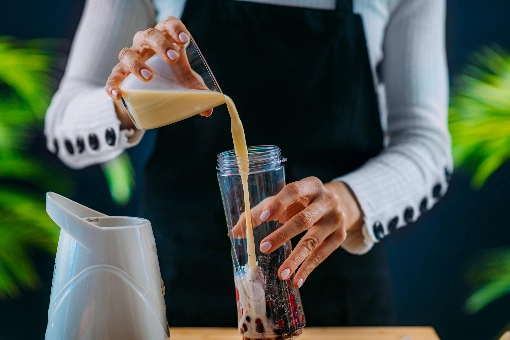
How do I brew the perfect tea for bubble tea?
Brewing the perfect tea for bubble tea is like putting together a symphony – it’s all about harmony. But don’t worry, you don’t need to be Beethoven to nail it. Here’s your cheat sheet to make tea that hits all the right notes.
The quest for the ideal bubble tea starts with choosing great tea. Whether you’re into black, green, or oolong, the quality of your leaves will make or break your brew. Next up, don’t neglect the water; it should be just hot enough to extract flavours without turning bitter. Steeping time is crucial – too short and your tea is weak; too long, and it’s as bitter as your ex’s text messages. Lastly, tweaking the strength just right ensures it’s not overpowering nor underwhelming.
How long should I steep the tea?
Steeping time is the Goldilocks zone of brewing – it has to be just right.
- Black Tea: Aim for 3-5 minutes. Too short, and it’s wimpy; too long, and you’ll pucker up from bitterness.
- Green Tea: Stick to 1-3 minutes. Green tea is delicate and oversteeping will make it taste like gym socks.
- Oolong Tea: Go for about 4-7 minutes. This one’s a bit more forgiving, but there’s no need to test its patience.
Steeping time directly affects the flavour and strength of your tea. So, set a timer, and don’t wander off mid-brew – your perfect bubble tea deserves attention.
What temperature should the water be?
Temperature can be the difference between a heavenly brew and a hellish slog.
- Black Tea: Boil it, baby! Shoot for around 100°C.
- Green Tea: Lower the heat! About 70-80°C is your sweet spot.
- Oolong Tea: Somewhere in the middle – around 85-90°C should do the trick.
Getting the temperature just right helps extract the right flavours while avoiding bitterness. No one enjoys kettle-scorched leaves, after all.
How can I adjust the tea’s strength?
Sometimes, life gives you weak tea, but that doesn’t mean you have to drink it.
- More leaves = stronger tea. Simple math, right?
- Longer steeping time – but tread carefully; there’s a thin line between strong and bitter.
- Double brewing: Brew a strong batch and mix it with your regular brew for an extra kick.
- Use less water if you want a punchier cup.
Aroma, flavour, and strength should dance together in perfect synchrony, making sure every sip of your bubble tea is vibrant and delightful.
Back in the early 1900s, tea lovers were as serious about their brew as we bubble tea aficionados are today. One such tea enthusiast, Lu Yu, spent his entire life perfecting the art of tea brewing. Considered the ‘Sage of Tea,’ Lu Yu authored the first known compendium on tea preparation and ceremony, the Cha Jing (The Classic of Tea), in the Tang Dynasty. His meticulous attention to detail, from water selection to brewing methods, resonates even in modern tea practices. Some bubbles in our tea tribute, if you will, to Lu Yu’s dedication to a perfect brew.
How do I assemble my bubble tea?
Alright, so you’re ready to take your bubble tea game from amateur hour to professional? Excellent move. Brewing the tea is just the warm-up; it’s the assembly where the real magic happens. You’re about to become an at-home bubble tea maestro!
But first, let’s set the stage. You’ve brewed your tea, cooked your tapioca pearls (those chewy little balls of joy), and you’re itching to mix it all together. Here’s the thing: the method to your madness is just as important as the ingredients themselves.
How much milk should I add?
It’s all about balance, my friend. The richer the milk, the creamier the bubble tea, but you don’t want to drown the tea flavour.
- A good rule of thumb is 1/4 cup of milk for every cup of prepared tea.
- If you’re feeling extra fancy, you can go for half-and-half or even a splash of heavy cream.
- Almond milk or oat milk can give you a nutty twist, while soy milk offers a different vibe.
- If dairy isn’t your jam, coconut milk can add a tropical flair.
Adding the milk slowly is the trick here. Pour a little, burst into a grin of anticipation, and taste. Adjust as you go. Remember, you can always add more milk, but an over-milked tea is a sad, lifeless disgrace.
What sweeteners can I use?
Next up: sweeteners. Bubble tea without sweetness is like a joke without a punchline – incomplete and unsatisfactory.
- Classic choices include simple syrup or honey.
- Brown sugar adds a bit of a caramel note.
- Condensed milk, because why not add sweetened creamy goodness?
- For a healthier kick, you can go with agave syrup or stevia.
- Maple syrup, because, you know, who doesn’t like a bit of maple?
Your chosen sweetener influences the kind of bubble tea you’ll end up with. Want it to taste like it’s straight from the streets of Taiwan? Brown sugar syrup all the way. More of a clean, classic vibe? Simple syrup has your back.
How do I mix the ingredients properly?
Now for the pièce de résistance—mixing everything together. The goal is a harmonious drink where each sip screams (or gently whispers) perfection.
- Start with a cocktail shaker. If your village doesn’t have one, a mason jar with a lid works too.
- Add the brewed tea first. Aim for 1 to 1.5 cups of tea.
- Next, toss in your sweetener. Like the milk, add a bit and taste, because over-sweetened tea will haunt your dreams in a bad way.
- Then, add your pearls. Measure about 1/4 cup of the cooked tapioca pearls per serving.
- Add ice. Lots of it. No one likes lukewarm bubble tea unless you’re a monster.
- Last but not least, add your chosen milk. Give it a good shake—the more vigorous, the better.
- Visuals matter. Pour your concoction into a tall, transparent glass.
- Top with additional pearls if you want that “I-made-this” Instagram cred.
- For the pro touch, throw in a wide straw that can handle those pearls without getting clogged.
The assembly completes the sensory journey. You want every sip to give you a hit of smooth tea, a chew of pearl, and a touch of sweet that makes you sigh with satisfaction.
What are some flavour variations for bubble tea?
Ever stared at the bubble tea menu and thought, “Why do they have so many options?” Yet, here you are, wanting more customisation at home. Let me introduce you to the wild and wonderful world of bubble tea flavour variations. Here’s how you can change things up and make your bubble tea experience a little less basic and a lot more exciting.
From fruity frolics to velvety chocolate indulgence, and even a green tea serenade, you’re in for a treat. Forget those boring plain milky teas; it’s time to step up your bubble tea game. Channel your inner bubble tea master and let’s get brewing!
How can I make fruit-flavoured bubble tea?
Fruit-flavoured bubble tea is like a party in your mouth. Here’s how you can make it:
- Choose your fruit: Popular options include strawberry, mango, passionfruit, lychee, and peach. Fresh or frozen, both work, but fresh is always a win.
- Blend your base: Mix your chosen fruit with water or milk. You can also use pre-made fruit juices or syrups if you’re short on time.
- Sweeten to taste: Add some sugar or honey (just don’t overdo it unless you want a sugar rush).
- Cool it down: Throw in some ice and blend until smooth.
- Combine with pearls: Add your tapioca pearls or any other jellies you fancy.
- Serve and slurp: Pour it into a glass, pop a chunky straw in, and enjoy.
With fruit flavours, the possibilities are endless. Think of fruits as the blank canvas of bubble tea; it’s all about finding what satiates your taste buds.
- Strawberries bring a refreshing sweetness.
- Mangoes offer a tropical vibe.
- Passionfruit adds a tangy twist.
- Lychee gives a delicate, floral touch.
- Peaches provide a smooth and juicy nuance.
Do you need a cheat code? Frozen fruit can be a lifesaver when your favourite fruit isn’t in season. Just don’t forget to adjust the sweetness, unless you’re aiming for toothache.
What is the recipe for chocolate milk tea?
Craving something rich and chocolaty in your bubble tea? Look no further. This chocolate milk tea recipe will take you to cloud nine and back:
- Brew your tea: Start with some strong black tea. Let it cool down before mixing.
- Prepare your chocolate syrup: Melt some good quality chocolate or use pre-made chocolate syrup. If you want to get fancy, add a pinch of sea salt.
- Mix milk: Combine your cooled tea with the chocolate syrup and milk (opt for full-fat if you want it ultra-creamy, but feel free to use any milk if you’re counting calories).
- Sweeten if needed: Taste and add extra sweetener if you have a sweet tooth.
- Combine with pearls: Don’t forget the pearls! They’re the pièce de résistance.
- Chill and serve: Add ice, shake it up and serve.
You thought chocolate was just for brownies and ice cream? Nah, we’re bringing it to your bubble tea realm, and it’s going to be epic.
- Strong black tea amplifies the chocolate flavour.
- Real chocolate syrup gives depth.
- Full-fat milk enriches the texture.
- Sea salt accentuates the sweetness.
- Combining the pearls transforms it into a thirst-quenching, mouth-watering delight.
Do I hear chocolate cravings now? Yeah, I know, thank me later.
How do I incorporate matcha into bubble tea?
Green tea bubble tea? Yes, please! Matcha isn’t just for zen moments anymore. Here’s how you can infuse your bubble tea with matcha goodness:
- Prepare your matcha: Dissolve matcha powder in hot water. For a smooth mix, whisking with a bamboo whisk or a frother works wonders.
- Cool it down: Let the matcha cool to lukewarm, unless you’re a fan of tepid drinks (which, let’s be honest, nobody is).
- Mix with milk: Combine the prepared matcha with your choice of milk. Almond milk gives a nutty twist, while oat milk offers a creamy alternative.
- Sweeten if desired: Add a touch of honey or simple syrup to balance the earthy flavour of matcha.
- Add your pearls: You know the drill – in go the pearls.
- Serve chilled: Pop in some ice, get your straw ready and sip away.
Who knew a zen drink like matcha could be this exciting in bubble tea form?
- Matcha powder offers a rich, earthy flavour.
- Bamboo whisking ensures a smooth consistency.
- Almond milk adds a nutty flavour.
- Oat milk provides a creamy texture.
- Sweeteners balance the slight bitterness of matcha.
Now, don’t just think of matcha as a solo performer. Pair it with flavours like vanilla, almond, or even mint to jazz things up.
How can I customise my bubble tea?
So, you love bubble tea, and now you want to take your home-brewed concoctions to the next level? You’re in luck! Customising bubble tea is an absolute blast. You can tweak everything from the milk to the sweeteners, and even add funky toppings. Let’s take a plunge into the different ways you can personalise your bubble tea.
Creating a unique bubble tea recipe at home is like giving yourself the power to be your own bubble tea barista. Toss out the notion of just sticking to the standard menu. Let’s have some fun, shall we?
What types of milk can I use?
Your choice of milk is the backbone of your bubble tea’s character. Gone are the days when cow’s milk was your only option. Today, the range is broader than Kim Kardashian’s handbag collection.
- Whole Milk: Rich and creamy, a classic choice.
- Skim Milk: A lighter option if you’re watching your calories.
- Almond Milk: Nutty flavour, great for lactose-intolerant folks.
- Soy Milk: Creamy and high-protein, ideal for vegans.
- Coconut Milk: Tropical vibe, and rich texture.
You can even mix and match these for a nuanced flavour. Think almond and coconut milk together for a nutty, tropical twist. If you’re feeling fancy, try oat milk. It’s like creaminess bottled.
What are some alternative sweeteners?
Sugar is sweet, but variety is the spice of life. Whether you’re cutting down on sugar or just want to mix things up, there are plenty of ways to sweeten your brew without turning it into a sugar bomb.
- Honey: Adds a floral note, a little goes a long way.
- Agave Nectar: Mild and dissolves well, great for cold drinks.
- Maple Syrup: A robust flavour, perfect for a hint of nostalgia.
- Stevia: Zero calories, and very sweet, so use sparingly.
- Monk Fruit Sweetener: No calories and a neutral taste.
Play around with these. You might find that maple syrup gives your matcha bubble tea a comforting, autumnal flavour. Or maybe honey elevates your jasmine tea to new heights.
How can I adjust the sweetness level?
Not a fan of sugar rushes leaving you vibrating like a phone on silent? Adjusting the sweetness level when making bubble tea is easier than you think.
- Less Syrup: Duh! Just add less of whatever sweetener you’re using.
- Dilution: Add more tea or milk to dilute the sweetness.
- Different Brew Time: Brew your tea for longer for a stronger base, reducing the need for sweeteners.
- Ice: Adding ice can mellow out intense sweetness.
Take control of your destiny—be the master of your own sugar domain. Start small and add more if you think your bubble tea is auditioning for a part in a Willy Wonka movie.
What are the common problems and solutions in making bubble tea?
Bubble tea, beloved and trendy, can feel like a beverage wizard’s concoction gone wrong if everything doesn’t go according to plan. From tapioca pearls with the consistency of shoe leather to flavour profiles that scream “Why?”, it’s a minefield of potential pitfalls. Let’s dive into the DIY drama and see how you can win at the bubble tea game.
Often, it’s the tapioca pearls that stage the first rebellion. Then there’s the matter of flavour—a delicate balance between delightful and diabolical. Ingredient scavenger hunts lead to frustration and, let’s not even start on tea strength that results in either weak swill or a tasting punch to the taste buds. And hey, what do you do with leftovers, anyway?
How can I fix chewy or hard tapioca pearls?
Tapioca pearls are the star attraction of bubble tea. But they can turn into a horror show faster than a cat spotting a cucumber.
- Chewy pearls: Under-cooking is usually the culprit. Boil the pearls for at least 30-45 mins and let them rest in warm water for another 30 minutes. Stick a fork in one to check—if you can easily bite through, you’re golden.
- Hard pearls: Overcooking these bad boys transforms them into little rocks. Reduce cooking time and let them sit in sugar syrup for enhanced chewiness.
- Consistency Issues: Ensure a steady cooking temperature—too high or too low heats sabotage the texture.
- Monitoring: Stir frequently to prevent them from sticking together or to the pot.
Getting the pearls just right is like walking a tightrope; balance and precision are key.
What can I do if the flavour is inconsistent?
The ultimate taste experience swings between amazing and ‘meh,’ depending on how you prepare it.
- Water Quality: Trust me, it matters! Poor water quality can make your tea taste bleh.
- Steeping Time: Over-steeped tea is as bitter as unresolved high school drama; under-steeped tea, weak and watery. Aim for 3-5 minutes to extract the perfect oomph.
- Sweeteners: Experiment with different types and amounts of sweeteners like honey, sugar, or even syrups.
- Milk Amount: Too much or too little milk changes the whole game. Adjust based on your taste.
- Ingredients Ratios: Maintain a steady ratio between tea, milk, and sweeteners to achieve a harmonious blend.
Getting the flavour just right can feel like a science experiment, but it pays off when you nail it.
Where can I find hard-to-find ingredients?
Hunting down exotic bubble tea ingredients can feel like a quest, but fear not!
- Asian Markets: These places are goldmines for everything bubble tea—from tapioca pearls to unique tea blends.
- Online Retailers: Amazon, eBay, and speciality online stores offer a plethora of options.
- Substitutions: Can’t find something? You’re not alone! Substitute with easily available ingredients. For example, use regular tea bags if you can’t find jasmine tea.
- DIY Kit: Purchase a bubble tea kit to get everything in one convenient package.
- Local Cafes: Sometimes, local bubble tea shops sell their ingredients.
Finding these ingredients might turn you into a grocery store ninja, but it’s well worth the effort.
Once, a Japanese soldier named Hiroo Onoda hid in the Philippines jungles for almost 30 years because he didn’t know World War II had ended. Imagine being that stubborn but for tea. When finding bubble tea ingredients makes you feel similarly ridiculous, remember Onoda’s pure tenacity. If he could stay committed, so can you in your bubble tea-making endeavours. So, get brewing and may your bubble tea always be flavourful and your pearls delightfully chewy!
How can I make bubble tea more cost-effective?
Alright, bubble tea enthusiasts! So you’ve been bitten by the bubble tea bug, but your wallet’s feeling the pinch, huh? Don’t worry, I’ve got your back.
Here’s the lowdown on how to make your homemade bubble tea as cost-effective as possible without skimping on the deliciousness. Keep reading if you want to save some serious cash while getting your boba fix.
First things first, let’s dive into bulk buying. Picture this: you walk into a massive warehouse filled with bubble tea goodies and hear that magical “Ahhh” sound as your wallet thanks you. Bulk buying means you pay less per unit – it’s simple economics, buddy.
Whether it’s tapioca pearls, tea, or even sweeteners, buying larger quantities upfront can save a ton in the long run. Just make sure you’ve got enough pantry space and maybe a spare cupboard or two!
How can bulk buying ingredients save money?
Here’s where the magic kicks in. Bulk buying isn’t just for doomsday preppers. It’s for savvy bubble tea addicts like you and me.
- Unit Costs Drop: Buying in bulk reduces the price per unit, which means you’re paying less for each scoop of tapioca.
- Less Frequent Shopping: You won’t have to keep running back and forth to the store (or waiting on deliveries) every time you run out of your beloved pearls.
- Discounts: Many suppliers offer discounts for bulk orders. Cha-ching!
- Fewer Packaging Costs: Less packaging waste also means less money spent on packaging, and you’re doing Mother Earth a favour.
So, in a nutshell: buy big, spend small. But don’t go too crazy – your pantry isn’t a tardis.
What are some homemade alternatives for ingredients?
Alright, let’s get those creative juices flowing because nothing says cost-effective like good old DIY.
- DIY Tapioca Pearls: Yup, you can make those chewy balls of joy at home with just tapioca starch and water.
- Homemade Syrups: Ditch the store-bought syrups and create your own using sugar and flavourings like fruit or honey.
- Custom Tea Blends: Don’t rely on fancy pre-mixed teas. Blend your own using loose leaf teas you already have.
- Alternative Sweeteners: Use agave, honey, or even homemade simple syrup instead of pricey, pre-made options.
- Milk Substitutes: Use whatever milk you have on hand, whether it’s cow’s, almond, soy, or oat. They all bring their unique twist to your bubble tea.
With homemade ingredients, not only do you save money, but you also have the freedom to experiment and create flavours that might just beat your local bubble tea shop’s menu.
How can I reduce waste while making bubble tea?
Less waste means less cost and less environmental guilt – it’s a win-win. Here’s how you can keep things green while sipping on your custom brew.
- Reusable Straws: Those stainless steel or silicone straws are life-savers for both your budget and the planet.
- Portion Control: Only make what you’ll drink to avoid leftovers that turn into a gloopy mess.
- Upcycle Containers: Use those cute glass jars to store ingredients or to serve your bubble tea.
- Compost Tea Leaves: Use those spent tea leaves in your garden compost if you’re into that sort of thing.
- Buy in Larger Packs: Going back to bulk buying – fewer trips to the store mean fewer bags, less plastic, and less waste.
Easy-peasy, right? A little bit of planning goes a long way in cutting down waste and costs.
Now, let me tell you about a thrifty marvel from history. During World War II, when food rationing was a thing, creative cooks whipped up wartime recipes that stretched ingredients like nobody’s business. One famous example is the mock apple pie, made entirely without apples!
They used Ritz crackers with lemon juice, sugar, and spices. It was so convincing that folks barely missed the real fruit. The same kind of creativity can go a long way in your bubble tea adventures. So put on your thinking cap, channel your inner wartime chef, and enjoy every sip without fretting over the cost.
Conclusion
As we’ve explored, making bubble tea at home can be a delightful and rewarding experience. From understanding the essential ingredients like tea leaves and tapioca pearls to mastering the brewing process and assembly, we’ve covered the nitty-gritty details needed to create this popular beverage. Knowing which types of tea to utilise and how to perfectly prepare the tapioca pearls can truly elevate your bubble tea game. It’s also important to recognise the customisation options available, allowing you to indulge in unique flavours tailored to your taste.
The significance of this knowledge stretches beyond mere enjoyment; it provides an opportunity to embrace creativity in the kitchen while saving money. By opting for cost-effective ingredients and discovering solutions to common problems, we can minimise waste and enjoy our favourite drinks guilt-free. This not only encourages us to hone our cooking skills but also fosters a greater appreciation for what goes into our consumables.
Looking ahead, I encourage you to experiment further with your bubble tea creations. Whether it’s trying out new flavours like matcha or chocolate milk tea, or adjusting sweetness levels to find your perfect blend, the possibilities are endless. Perhaps the next step is to host a bubble tea tasting event with friends or family, where each person can bring their unique twist to the table.
As I reflect on my own journey with bubble tea, I’m reminded of the joy it brings—nothing says comfort quite like a homemade bubble tea in hand. So, as you embark on your own bubble tea adventures, I leave you with this thought: Why just enjoy bubble tea, when you can create your signature version? Happy brewing!
Resources
- Role of sweet and other flavours in liking and disliking of electronic cigarettes
- Factors influencing consumers’ willingness to use beverages and ready-to-eat frozen soups containing oat β-glucan in Finland, France, and Sweden
- Tapioca Pearls: A Review of Their Production, Properties, and Applications


